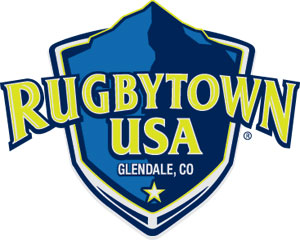
by Mark Smiley | Mar 1, 2018 | Glendale City News
by John Arthur
Writer for and on behalf of the City of Glendale

Glendale coach Dave Synnott, originally from England, began playing rugby as a youth and his coaching resume is a handsome one.
Last December nearly 200 athletes, all of them High School All-Americans, traveled to Arizona for USA Rugby’s 2017 Boys High School All-Americans Camp. Joining them was Glendale’s Under-23 team head coach, and professional Glendale Raptors strength and conditioning coach Dave Synnott. Attending in an administrative and coaching capacity, Synnott spent the five-day camp at Casa Grande Sports World interacting with the next generation of rugby talent.
Head Coach Salty Thompson oversees the USA Rugby 15s and 7s High School All-Americans teams and orchestrated the December camp. Athletes invited to the camp must first be named All-Americans, meaning they were likely scouted while playing in one or more of five annual tournaments, known as Regional Cup Tournaments. The largest and most attended Regional Cup Tournament, known as the Rocky Mountain Cup Challenge, takes place in Denver each June. Selection by the All-American scouting network is not the exclusive path to an invite, however, with some participants selected through the Eagle Impact Rugby Academy (EIRA), and others scouted while playing in high-performance rugby events.
All-Americans teams are comprised of players from across the United States, and field both 15s and 7s squads. The December gathering of the best young rugby talent from across the country was the largest in some time, with 184 athletes in attendance alongside more than 30 coaches, trainers, and staff. Players are grouped according to their ages, with the camp fielding Junior Varsity (Under 17) and Varsity (Under 19) teams. Synnott noted that he acted largely as a coach during the camp, and that he worked primarily with the U17 and U18 players.
The focus of the five-day gathering is on individual skill development, involving not only physical training and scrimmaging, but also strength and conditioning work, classroom sessions, and cognitive training. Camp days are full: participants wake before 7 a.m., followed by stretches, breakfast, a classroom session, and then two hours on the training paddock. A coaches’ evaluation precedes lunch, then it’s back to the classrooms for another session before more training or a scrimmage. Following an evening meal, players review the day before a final coaches’ evaluation and more stretching. The lights are out at 10 p.m.
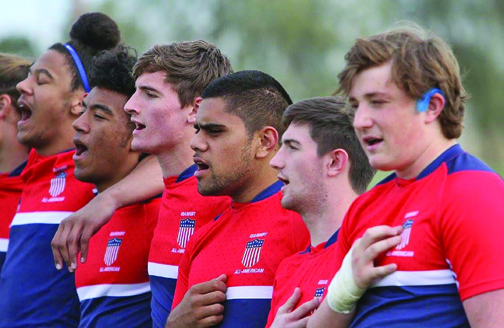
The Boys High School All-Americans sing the national anthem before one of their matches with Canada during the 2017 USA Rugby High School All-American Rugby Camp in Arizona.
Glendale coach Dave Synnott, originally from England, began playing rugby as a youth, representing the East Midlands in Academy level competition. His coaching resume is a handsome one, having worked extensively at the high school level, and winning two U.S. national titles as an assistant coach for a women’s college team. He describes this period of extended success as the time when he fell in love with coaching. Synnott moved to Colorado in April 2017, and endeavored to join the Raptors immediately, “I reached out to Raptors coach Dave Williams and said I’d love to get involved. I started with the men’s D2 team, then Dave let me run some drills with the elite guys, and since then I’ve been doing the skills part for them. They made me head coach of the U23 team in June.” Synnott’s role in Glendale and at the All-Americans camp is significant: he is helping to shape the future of rugby talent in the United States.
Embracing the excitement of international competition, the December camp included matches against two of Canada’s Under 18 teams. Synnott describes the action: “The Canadian teams trained all week, and then we scrimmaged them on the second day and the last day. It’s a way for the boys to get an international taste of the game, and also to get the Americans and the Canadians an extra couple of games in the winter.” The presence of the Canadian competition brought an additional level of excitement for the players, as well as furthered development. Synnott noted that the level of play at the camp was exceptional, “There were definitely some future Eagles at this camp and some future MLR talent as well.” With Glendale’s U23 team poised to act as a true feeder team for the professional Raptors squad, this is high praise.
The Glendale Raptors Rugby Academy Elite Development Program offers a pathway to professional-level competition for players under 23 years of age. Synnott explains the Academy’s strategy moving forward, “We are recruiting the top talent in the country out of high school. We have a good relationship with EIRA (Eagle Impact Rugby Academy), which is run by Salty Thompson, and he will send players our way if they’re not going to college or if he thinks they’ve got a professional prospect. It’s definitely a program that’s building for the future and it could be very handy for the MLR Raptors team.” Although scouting was not permitted at the All-Americans camp, it is clear that Synnott, and Glendale, have their proverbial finger on the pulse of young rugby talent in the country. Building on a history of distinction, it’s clear Raptors programming will continue to be among the strongest in the nation.

by Mark Smiley | Mar 1, 2018 | General Featured
by Ed Mate, Executive Director
Colorado Golf Association
For most golf fans the return of Tiger Woods is a long overdue and welcoming sight. It is well documented that Tiger’s influence on Nielsen ratings is as direct and powerful as low interest rates on the stock market. What amazes me are those who believe that the sport either a) doesn’t really need him or even, b) is better off without him. For those it goes something like, “We have all of the young guns, like Rory, Rickie, Jordan and Dustin.” Pardon me, but that sounds more like roll call at an after school daycare than the lineup of a world class sports franchise like the PGA Tour. Let’s be honest folks, the PGA Tour needs Tiger — no, not to survive, but if the sport hopes to enjoy anything remotely close to its previous notoriety, cache and basic “cool factor” it is going to need more than Chez Reavie and Ryan “I’m no Arnold” Palmer slugging it out on the back-nine on Sunday.
Personally, the reason I am excited about Tiger’s return is only partly due to his amazing talent and golf charisma. Yes, I will enjoy watching him attempt to regain his previous form, but I am more interested in seeing how he can use his “rebirth” (if indeed that is what we are witnessing) to influence a sport that has evolved significantly since his last major championship win in 2008. Over the past 10 years the game has rolled out more innovative and forward-thinking growth of the game initiatives than it did in the previous 100 years. Drive-Chip-Putt, PGA Junior League, LPGA/ USGA Girls Golf, and Youth on Course are four of the keystone programs that have been embraced by the golf community on the local, state and national level. These programs are all designed, in different ways, to attract a wider and more diverse audience to the sport. Time will tell if they will be successful, but early evidence is extremely encouraging.
What does all this have to do with the Colorado Golf Association, or for that matter, what does it have to do with the Denver and Cherry Creek corridor who receives this publication? Quite a lot actually. The Colorado Golf Association just so happens to own and operate CommonGround Golf Course, the former Lowry Air Force Base course that went through a complete metamorphosis in 2008 — the same year Tiger took down Rocco Mediate in an 18-hole playoff to win the U.S. Open — the last of his 14 major golf championships. CommonGround, as its name suggests, was designed to be “a place for all and all the game teaches.” CommonGround is the Colorado Golf Association’s vehicle to introduce golf to those who previously had no access to the game.
The CommonGround campus includes an 18-hole championship golf course designed by world-renowned architect, Tom Doak. But it also includes a practice facility that is regarded as one of the best in the state, a nine-hole Junior Par 3 course that is absolutely free to kids under the age of 18 and an expansive community putting green that is free to everyone with a putter and some time on their hands. But more important than the campus itself, it is the programs that are hosted at CommonGround that make it such a community asset. Among these programs is the Solich Caddie & Leadership Academy that was featured in this publication last year — a program that introduces 30 to 35 young adults (mostly 8th and 9th graders) to a summer job, leadership training, and community service. The CGA uses CommonGround to create partnerships with organizations such as Big Brothers-Big Sisters, Special Olympics and a dozen neighborhood schools to bring the game to those who would never otherwise experience it. CommonGround hosts over 200 outside groups every year who make use of the facility to raise money for charity, provide after work recreation to their employees, or simply provide a gathering place for old friends.
CommonGround most certainly is living up to its name, but I can’t help but wonder how much more we could do with a champion like Tiger Woods serving an ambassadorial role. The community surrounding CommonGround is one of the most diverse of its size anywhere in the country. When you drive the Havana corridor you will see every ethnic restaurant you can imagine. Wouldn’t it be cool if Tiger used his notoriety and global brand to encourage those living in this community to identify more strongly with the sport of golf? Tiger has described himself as a “Cablinasian” speaking to his Caucasian, Black American, American Indian and Asian heritage. What could be more perfect to promote CommonGround and all it represents than Tiger Woods’ return to the world stage of golf?
With Tiger’s return it is my hope that he will do more than simply hoist trophies once again. It is my hope that instead of slamming clubs and dropping expletives, the new and improved Tiger will speak more openly about his diverse ethnic background and encourage those who look more like him to consider taking up the sport. Ultimately, Tiger Woods can do so much more than move the needle with sponsors and televisions viewers. He truly can help change the face of the game and those who play it for generations to come. In 2008 the game of golf wasn’t ready and neither was Tiger. Today the game has done its part as evidenced by what is happening right here at CommonGround.
Come on, Tiger, it’s your turn!
Tiger’s Back: Tiger Woods competed in his first back-to-back tournaments since April 2017 when he teed off at the Honda Classic on February 22, 2018, at PGA National Resort and Spa in Palm Beach Gardens, Florida.
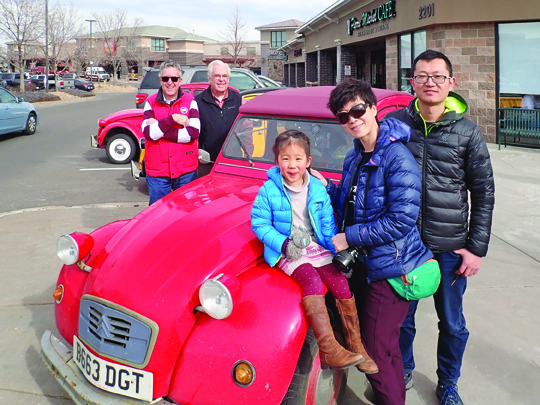
by Mark Smiley | Mar 1, 2018 | Travel
by Lisa Marlin

Around The World: At the Pierre Michel French Cafe in Littleton, Camilo Salazar, left, and Gary Daniels, met up with Jie Ding, Chang Luo, and their daughter Yuding who are traveling around the world in their 1985 Citroën 2CV.
England. Russia. China. Colorado. Nine months into their two-year road trip, the Luo Family has traveled to all these places with their primary mode of transportation being a red 1985 Citroën 2CV. This small, no-frills French car was produced from the late 1940s to 1990 and still garners interest worldwide.
A group of Denver-area Citroën enthusiasts greeted Chang Luo, wife Jie Ding, both 38, and their four-year-old daughter Yuding, when the family stopped for lunch at a French café in Littleton on January 31. They’d recently journeyed to the Arctic Circle and were driving south through the Americas.
“It’s just life on the road,” said Ding, after unbuckling Yuding from a car seat in the back where their luggage is also stacked. “Chang enjoys cars so much and I enjoy traveling and meeting people so much and this car just combines our interests, so we enjoy it.”
This is not their first road trip. In 2011, Luo got the job of an automobile engineer in London. Before moving there, he and Ding carefully studied the feasibility of driving from their home in Shanghai to his new job in London along the ancient Silk Road and decided to do it. Five years later he bought and restored the Citroën, then he quit his job so he and Ding could take their young daughter on an even longer road trip before she starts school. Why travel in a 33-year-old car? “This car is very interesting. I put a lot of effort into it. It has to be this car,” he said.
Ding said the experience enriches their family time. “For two years we can spend 24 hours a day together, to plan together, to see things together. I think that’s really important and we appreciate that we have this time to do that,” she said.
The first leg of their trip began in April 2017 when they left England and drove through 19 countries on their way to China to visit family and friends. From there, they shipped the car to Vancouver, British Columbia.
“I do almost all the driving,” Luo said. “And the car needs attention from time to time, maintenance, servicing, and I do it all myself.” This seemed to be especially true in Colorado. “The elevation of Colorado is phenomenal, and the car feels it. The power has lost quite a few horses I would say, and the start can be quite tricky.”
He lifted the hood as the local Citroën enthusiasts gathered to peer inside and talk with him about the engine. Among them was Camilo Salazar who has owned several of the cars and keeps in contact with other owners around the world; that’s how he heard about the Luos’ trip and began emailing with them to help coordinate their trip through Colorado.
“The Citroën has the most impressive suspension in automobiles ever,” Salazar said, which makes it great for long distance trips. He said it’s also very simple to work on. “It’s basically a glorified lawnmower,” he said, which makes it louder than most cars and slower, topping out at 70 miles per hour.
Denverite Gary Daniels drove his Citroën across town to meet the Luos. It’s one of several he’s owned over the years. “Everybody has an interest in the car. You just have to ride in one,” Daniels said. “It’s so very versatile.”
Versatility can be important when traveling around the world in a car. Even though the Luos have a general plan to reach Argentina in a year, they’re not following a

Under The Hood: The Citroën is an air-cooled front-engine, front-wheel-drive economy car introduced at the 1948 Paris Mondial de Automobile and manufactured by Citroën for model years 1948-1990. In total, Citroën manufactured almost 9 million 2CVs and variants.
direct route by any means. After leaving Denver, they drove up Pike’s Peak, which was on their must-visit list in Colorado, but then changed their plans to head south from there, and instead ventured toward Montreal to celebrate the Chinese New Year with friends. On February 20, they sent word that they would be going to New York before traveling toward southern California where they’ll cross the border into Mexico. Wherever they go, they mostly stay in the homes of families they meet along the way or that they find through hospitality and networking services such as CouchSurfing.
Ding is blogging, in Chinese, about their adventure so their family and friends back home can keep up. “We have lots of stories to share with our followers to tell them what is going on in other countries. The normal family, what do they do?” she said. “Meeting car club friends has been the best part of our trip, we have been so surprised to see there are still quite a lot of Citroën fans in North America.”
After having lunch in the French café with their new Colorado friends, the family loaded back into their Citroën, buckling Yuding in her car seat. Luo said his daughter is coping very well with her new lifestyle. “She entertains herself in the car by drawing, singing, looking around, especially when we were in the north, in Alaska and northern Canada where there were many wild animals. That was a lot of fun.”
In a blink, they were off again, wide-eyed and heading down the highway in their bright red Citroën, adventure bound.

by Mark Smiley | Mar 1, 2018 | Editorials
 Denver media recently hyped that the eating and entertainment district along Cherry Creek near Virginia Avenue known as Glendale 180 is once again right around the corner. Channel 7 News declared that the “city could break ground as early as next year.”
Denver media recently hyped that the eating and entertainment district along Cherry Creek near Virginia Avenue known as Glendale 180 is once again right around the corner. Channel 7 News declared that the “city could break ground as early as next year.”
Deputy City Manager Chuck Line is quoted in a February 19, 2018, story in The Denver Post about the project: “Before, we were barely getting out of the driveway, and now we’re definitely driving down the interstate.”
Oh, pleaseeeeee! Members of this Editorial Board were instrumental in envisioning The Glendale Riverwalk which was later retitled Glendale 180 as far back as 2003. Since then, every few years the city has publicly announced that a groundbreaking would occur in the next 12 to 18 months.
Of course, it is not entirely the city’s fault. After an announcement that the city was envisioning building a Riverwalk modeled after the one in San Antonio, Texas, Mohammad Ali Kheirkhahi and his family who own Authentic Persian and Oriental Rugs rushed out and outbid the city for the 3.8 acres of developable land fronting Colorado Boulevard from longtime owner Jimmy O’Connor.
Grossly overpaying for the land, Kheirkhahi and his family apparently hoped to hold up the city for over three times what they paid for it. When the city declined, they went out and asserted the city was threatening eminent domain and organized potentially violent marches with the para-military groups like the Oath Keepers and others in an attempt to cow the City Council.
When that failed, the rug merchants brought a series of highly expensive lawsuits utilizing some of the most expensive lawyers in Colorado and the nation to stop any d

evelopment on land other than theirs. Having lost those lawsuits after spending hundreds of thousands of dollars, Kheirkhahi and his kin have filed numerous questionable ethics complaints with the highly dubious Independent Ethics Commission.
But the rug merchants may have finally outsmarted themselves. At their request the Kheirkhahi land was excluded out of Glendale’s Downtown Development Authority. Thus any development on their land cannot by law receive any tax increment financing. Because of that fact Kheirkhahi’s land is now worth a great deal less to any potential purchaser.
Having beaten back the rug merchant’s vicious attempts to destroy Glendale 180, the city has now entered into a Development Agreement with the highly regarded Lincoln Properties. But that is only the first step, and not the last, in getting Glendale 180 to become a reality. The next crucial step is agreeing to a “Financing Agreement” whereby the parties concur on how to pay for everything. Many a project in Colorado has died due to disagreements on who and how everything is going to be paid.
If that huge hurdle can be overcome, Lincoln Properties must submit a Site Plan for the land which would meet the public’s approval and garner a majority of the City Council. Even if that is obtained there is no assurance that the bonds and other financing instruments envisioned by the “Financing Agreement” can be successfully marketed. That will in part depend on how Colorado’s economy is doing when the city goes to the financial markets.
Thus, with all due respect to Mr. Line, we are afraid the city is hardly cruising along the highway to the destination of a completed project but rather Glendale has but simply left the driveway. When a “Financing Agreement” has been signed and a “Site Plan” approved, talk of a possible groundbreaking ceremony becomes viable, but even then, by no means assured.
We will let our readers know from time to time how Glendale and Lincoln Properties are doing regarding their goal of getting to a completed project. Excessive hype in the early stages of an actual project is not always helpful. Congratulations to Glendale and Lincoln Properties on the Development Agreement, but a great deal of hard rowing still awaits all involved.
— Editorial Board
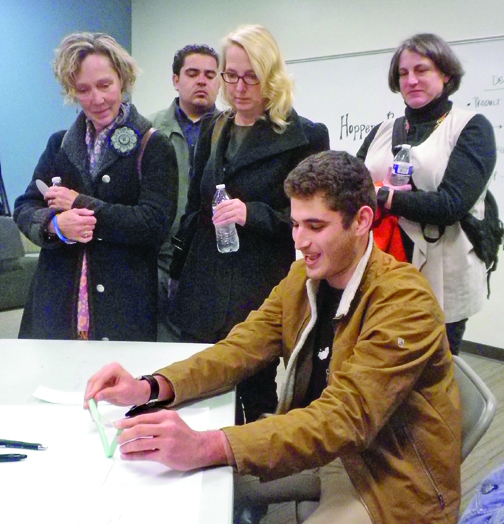
by Mark Smiley | Jan 29, 2018 | General Featured
The CUBE Focuses On Innovative Learning And Real-World Experiences
by Ruthy Wexler
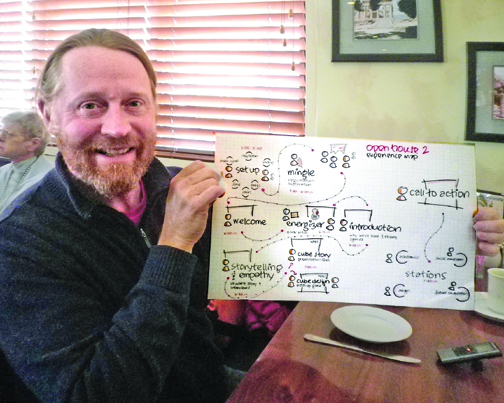
Co-Founder: Jim Stephens, co-founder of The CUBE, displays his plans for the Open House that was held on January 8, 2018. Stephens hopes to have enough students enrolled by the end of February 2018. The requirement is 93.
The CUBE, a new high school in Denver, is ready to enroll students and eager to explain how their innovative program not only boosts reading, writing, and math skills, but connects students to the real world — and their best selves.
Since Denver Public School’s school choice enrollment takes place February 1-22, The CUBE held a series of Open Houses in January, “so kids and parents could see who we are and what we do.” At the first one, held on January 8 in The CUBE’s temporary home, Vickers Boys and Girls Club, an attentive, curious group began to grasp how profoundly different this school would be.
“But don’t you have … classes?” one mother asked.
“Yes, we have classes,” smiled co-founder Bret Poppleton. “But they’re not what you’re used to. One course students can take first semester is ‘Flour, Water, Salt and Yeast.’”
“They bake bread?” said a puzzled adult.
“Yes. And that’s fun and engaging. But they also learn chemistry, math, research, writing … because all those things are involved.”

Presentation: Bret Poppleton, co-founder of The CUBE, explains CUBE concepts to parents at the Open House. School Choice for Denver Public Schools runs from February 1 to 28, 2018, and CUBE supporters hope to enroll 135 students.
Because It Was Real
“We call our courses ‘mash-ups,’” Poppleton explained. “An interdisciplinary smashing together of ideas that teaches students to think more deeply about the world. It’s actually how real learning happens. Not linear but from all directions. Starts with being engaged.”
He shared an epiphany. “In middle school, I was always complaining, ‘Why do I have to learn this?’ Then, between 10th and 11th grade, I spent a week in construction, building homes. I learned more that week, it seemed, than in a whole year of school. Because it was real.”
The CUBE’s other founder, Jim Stephens, told much the same story. “Between my sophomore and junior years of college, I went to Jamaica, a summer field school for anthropology. At first, I thought, great, a vacation. But doing excavations right there on sugar plantations with descendants of enslaved people, I understood history so deeply. I drew the artifacts, made maps. It all connected. For the first time in my life, learning came alive.”
Based On Research
What happened in Jamaica — what will occur at The CUBE — is “integrated learning,” said Stephens, who honed his educational skills for years before embarking on a “national search for the kind of place I wanted to teach” — and landed at the Denver School of Science and Technology (DSST).
“I learned so much there,” recalled Stephens, whose passionate interest in the swiftly-shifting future was shared by DSST colleague Bret Poppleton.
The more the two learned how the world was changing — how radically different the work force will soon appear — the more they wanted to equip students with the skills to “pivot”; i.e., change direction with confidence.
Soon they agreed: “Let’s open up our own school.”
“First, we needed to understand the teenage brain the same way that Montessori understands the early years,” Stephens recalled. “Studies show, for example, that the brain’s sleep pattern changes markedly during adolescence. That’s why teens fall asleep in early classes. Our classes won’t start until 9 a.m.” [Although The CUBE will stay open from 7 a.m. to 7 p.m.]
Questions
On January 8, impressed parents nonetheless had worries.
“What about standardized testing?”
“Yes, we take them. All our kids will learn to read, write, compute and think, skills absorbed so much more easily when engaged,” said Poppleton.
“Is there homework?”

Demonstration: Abcim Molavi, former student of The CUBE’s co-founders, demonstrated his solution to the Hopper Project as parents look on at the Open House held in January. The Hopper Project is statistical machine learning for advanced search of mathematical and scientific literature.
“Working on a project, doing research, that’s homework,” Poppleton said. “But they’ll love what they’re doing and learn more.”
“What about transcripts?”
“We have a transcript format that includes the traditional information, as well as social-emotional and 21st century skills data.”
“Accountability?”
“We offer fun and engagement, so we expect more participation. But we have expectations too. When students finish one of the mash-up classes, they must do three things: write a paper, create a product, do a presentation.”
Future
Earlier, Jonathan Best, The CUBE’s “Computation Jedi,” had led students to an adjoining room. After an hour, parents joined the kids, who’d been divided into groups and instructed to build “something that moved” from a box of ordinary objects.
“We’re telling them, ‘You’re smart, you can figure out how to build something that moves from these few materials,’” explained Best. “It’s not about competing. It’s building confidence to think outside the box.”
The CUBE’s founders excitedly envision a student body “where every kid knows how to code,” week-long courses “that take place in the real world, like an ice-climb in Ouray,” unlocking “the huge potential inside each child.”
Currently, they’re addressing the challenges of any new school.
“Fundraising. Finding the facility. Getting kids,” listed Poppleton. “We’ve already raised $2.5 million.”
“We’re going to take 135 students,” said Stephens. “Or more. But by the end of February, we have to have 93.”
What if too few sign up?
He smiled gently. “Well… then people aren’t ready for our school.
“But I hope they are. We’re ready for them! We can’t wait to show how powerful storytelling and empathy and mash-up classes are.
“We don’t use the term ‘alternative’ — because we believe all schools should look like this. And will, in the future.
“It’s just that The CUBE is doing it now.”
For more information, go to www.thecubeschool.org.

by Mark Smiley | Jan 29, 2018 | Travel
Have A Dog-Gone-Good Time At Chinese Bark In The Park Party
Bowwow The Night Away At Chinese New Year Gala
With Your Puppy Love, Pampered Pals At McNichols Feb. 9
One of the most internationally celebrated events of the year, the Cherry Creek Valley’s Chinese New Year Celebration hosted by the Nathan Yip Foundation has become one of the biggest and best in the nation. This year’s event commemorates the Year of the Dog — the 11th in the 12-year cycle of Chinese zodiac

Party Palace: The Cherry Creek Valley’s Chinese New Year Celebration is in the McNichols Bldg. on the northwest corner of Civic Center Park, Feb. 9, 6 p.m.
sign events — in the McNichols Bldg. on the northwest corner of Civic Center Park, Feb. 9, 6 p.m.
No bones about it, attendees will get caught up in the energy as they chase after their dreams in the Valley’s first and original Chinese party. Now in its 15th year, it is one of the biggest of its kind outside of China. Spread over three floors of the McNichols Party Palace, the multitude will have a “dog-gone-good time” enjoying food, interactive entertainment, plus an authentic Chinese Night Market.
All proceeds from the evening will benefit the Foundation’s funding of educational projects for the most vulnerable children in rural Colorado and China. Last year’s Chinese New Year Party raised more than $250,000. The Foundation is named for the son of Denver residents and founders Linda and Jimmy Yip. The Yips lost their only son Nathan in a 2002 car accident. For years the Yips, with a team of volunteers and friends, built schools and provided supplies to rural, forgotten areas in China. Now they are putting that same effort into rural Colorado communities.
Run With Big Dogs
Dog is man’s good friend who can understand the human’s spirit and obey its master, whether he is wealthy or not. The Chinese regard it as an auspicious animal. If a dog happens to come to a house, it symbolizes th
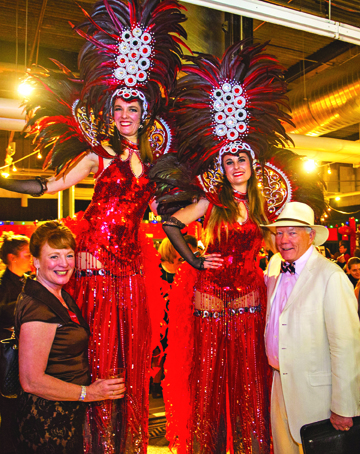
Chinese Characters: Attendees at Nathan Yip Foundation Chinese New Year Celebration will meet colorful characters at party Feb. 9. Now in its 15th year, it is one of the biggest events of its kind outside of China.
e coming of fortune. The invincible God Erlang in Chinese legend used a loyal wolfhound to help him capture monsters.
According to Lunar New Year pros, the Year of the Dog will be a good year for action and should offer new business opportunities and, furthermore, is conducive to festivals, especially fundraisers such as the Nathan Yip Foundation celebration.
Guests will run with the big dogs at this year’s canine carnival featuring world-class performers including lion dancers, a karaoke stage, silent disco, fortune teller, Chinese calligraphers and portrait artists. More: This year guests will also be blessed watching the “im’paws’ible” as dogs entertain. Acro Dogs — good doggies performing for this good year — are an added attraction. It’s the Year of the Dog after all, and you’ll discover dogs have talents ranging from Yoga and Irish dancing to painting and more.
Indoor Street Party
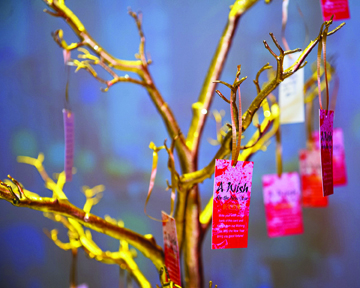
Tree Of Luck: According to Lunar New Year pros, the Year of the Dog will be a good year for action and should offer new business opportunities.

East Meets West: The biggest and most colorful celebration in the East is now one of Denver’s biggest party events. The Nathan Yip Foundation celebration provides funding for educational projects for the most vulnerable children in Colorado and China.

Dog-Day Night: This year’s event commemorates the Year of the Dog, the 11th in the 12-year cycle of Chinese zodiac sign events.

Night Market: Spread over three floors, attendees will have a “dog-gone-good time” enjoying food, interactive entertainment, plus an authentic Chinese Night Market.
This year’s colorful celebration is getting an exciting twist of the dog’s tail: The festive, fun-filled Chinese-themed Night Market has been expanded. It’s a new-fangled version of a street party complete with troupes of acrobats, Chinese lion dancers, and of course tasty themed food stations. It features fabulous foods, thrilling lion dances, and shock-red lanterns.
In addition to themed food stations and full open bars, the Indoor Night Market offers fun wares for sale, just like travelers see throughout Asia.
The delicious and diverse tasting stations will feature food prepared by Denver’s Catering by Design. The Seattle Fish Company is sponsoring the marketplace. The company’s CEO James Iain went to school with Nathan Yip.
Helping At Home
Because the annual event celebrates Chinese New Year, many people think all of the Foundation’s work is still in China. However, as the world has changed, so has the focus of Foundation’s effort.
In the metro area the Foundation continues supporting such groups as the George Washington High School’s Mentoring Program, Patriot Pairs. The Foundation contributes all of the expensive graphing calculators for the all mentees plus finds the most overlooked areas to help. At East High School, Nate’s Pass Program supplements bus passes for students that need transportation to school.
“But the real forgotten areas of Colorado are the rural areas,” according to Board Member Denise Gliwa. There are not many organizations traveling to the far corners of our state and learning and recognizing the educational needs of these students and school districts, she notes. With a “hands on” approach, Jimmy and Linda Yip travel to these areas and really find out their educational needs.
Country School Upgraded
Some of the work the Foundation did during the past year included a Technology Grant to Eads High School to upgrade its science classes so students can actually do experiments. The ventilation in the classroom was so bad students could not do the necessary work.
At San Luis Valley’s Center Consolidated School District the Foundation provided funding for teacher pay so that every teacher could do family Home Visits in the small agricultural community.
The Foundation also urbanized a professional development partnership between the schools in Montezuma-Cortez with the STEM School in Highlands Ranch. The STEM teachers visited Montezuma-Cortez and the MC teachers and admin visited STEM to learn and share ideas.
Providing Computers
A team of volunteers last year traveled to the San Luis Valley and dropped off 40 laptop computers to the San Luis Valley Board of Cooperative Education Services (BOCES). The computers were distributed to students in the area who do not have a computer at home.
Following that, the team delivered another 40 laptop computers to the Ute Mountain Ute Reservation, for the same purposes.
An additional 40 computers were distributed to Colorado’s Eastern Plains plus 18 to Eads. This was done in cooperation with Rose Keating and her organization Tech For All. The decision to provide the computers was made because students without computers at home are at a huge disadvantage when it comes to computer literacy. Information: 303-817-8400.



















